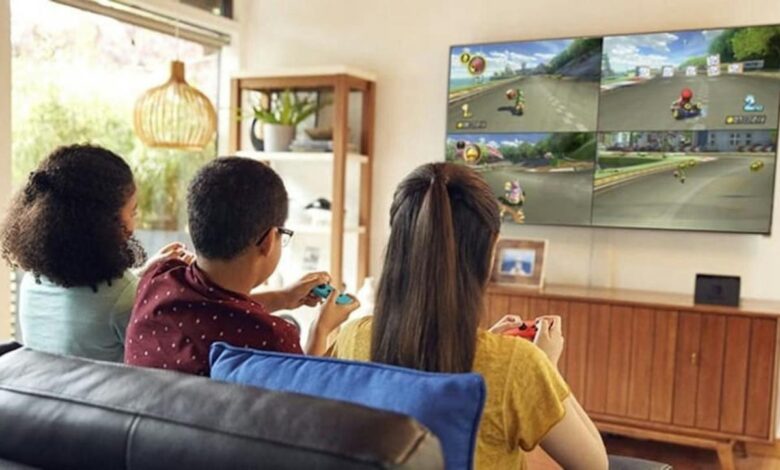Family-Friendly Games Strengthen Bonds through Generations

The world of gaming, once stereotyped as a solitary hobby for teenagers, is undergoing a profound and heartwarming transformation. A new era of family-friendly gaming is emerging, where video games are not just about entertainment but are powerful tools for bringing people together, strengthening bonds, and creating shared experiences that span generations. This isn’t just about a niche market; it’s a fundamental shift, driven by a new generation of game developers and a growing recognition that a digital world can be a force for positive, meaningful connection. This article will take a deep dive into the core concepts of family-friendly gaming, exploring the groundbreaking applications that are revolutionizing communication and collaboration. We will also examine the challenges that still need to be addressed and the immense opportunities that lie ahead for a more connected and joyous future.
The New Purpose of Play

Family-friendly gaming is about more than just a lighthearted theme or a cartoonish art style. It is a philosophy of inclusive design, where a game is created with the intention of being accessible, engaging, and rewarding for everyone, regardless of age or skill level. The goal is to create an experience that can be shared by a parent and child, a sibling and a grandparent, or a group of friends.
A. The New Social Hub
For many families, the living room has been a place for passive entertainment. The new era of family-friendly gaming is turning the living room into a new social hub, a place for active, cooperative play.
- Shared-Screen Multiplayer: The most direct way to bring a family together is with a game that can be played on a single screen. This creates a sense of shared presence and a new level of social interaction that is often missing from our digital lives. Games that feature simple mechanics, a cooperative goal, and a focus on teamwork are particularly effective.
- Cross-Platform Play: The ability for a family member on a console to play with a family member on a PC or a smartphone is a game-changer. This eliminates the friction of different gaming platforms and allows a family to connect and play together from anywhere in the world.
- The New Family Night: The traditional “family night” of a board game or a movie is being replaced by a night of gaming. This is a new way for a family to bond, to share a laugh, and to create new, cherished memories.
B. The Power of a Shared Experience
A family-friendly game is a shared experience, a journey that a family can take together. It is an opportunity to laugh at a silly mistake, to cheer for a shared victory, and to work together to overcome a difficult challenge.
- Cooperative Gameplay: Games that require a family to work together to achieve a common goal are a powerful tool for strengthening bonds and fostering a sense of teamwork. It’s a low-stakes environment to practice communication, problem-solving, and a spirit of collaboration.
- Problem-Solving and Creativity: Many family-friendly games are designed around a series of puzzles and challenges that a family must work together to solve. This can be a fun and engaging way to encourage critical thinking, creativity, and a new kind of family-based brain-storming.
- A New Kind of Storytelling: Family-friendly games are also telling a new kind of story, with a focus on themes of friendship, courage, and family. The ability for a family to experience a beautiful, emotional story together is a powerful new form of entertainment that can create a shared memory that will last a lifetime.
The New Design Philosophy
The new era of family-friendly gaming is defined by a new philosophy of design that puts accessibility and inclusivity at the heart of the creative process.
A. Simple, Intuitive Mechanics
A family-friendly game must be accessible to everyone, regardless of age or skill level. This requires a focus on simple, intuitive mechanics that are easy to learn but difficult to master. The goal is to create a game that a grandparent can pick up and play in a matter of minutes but that has enough depth and complexity to be engaging for a seasoned gamer.
- Playful Art Style: The visual design of a family-friendly game is often playful and inviting, with a focus on vibrant colors, a charming art style, and a cast of memorable characters. This makes the game more approachable and less intimidating for a casual gamer.
- A Focus on Fun: The most important rule of family-friendly gaming is that the game must be fun. The focus is on a lighthearted, joyous experience that is a source of laughter and a positive memory.
B. Inclusive Gameplay
A family-friendly game must be inclusive, with a focus on a wide range of skill levels and a variety of ways to play.
- Variable Difficulty: The game should have a variety of difficulty settings, so that a family member who is new to gaming can have a rewarding experience without being overwhelmed.
- Assistive Features: The game should have a variety of assistive features, such as an optional co-op mode or a a mode with a forgiving penalty system for a player who makes a mistake. This ensures that every family member can feel a sense of success.
- The New Learning Tool: Family-friendly games are also being used as a new kind of learning tool. They can be used to teach a child about history, science, and math in a fun, engaging, and interactive way.
Challenges and Opportunities

While the future of family-friendly gaming is bright, there are significant challenges that must be addressed to ensure that this revolution is inclusive and sustainable.
A. The Need for a New Business Model
The traditional business model of a family-friendly game is a one-time purchase. This can be a major challenge for a game that is designed to be a continuous experience. A new business model, such as a subscription-based model or a game as a service, is needed to ensure that a family can continue to enjoy a game for years to come.
B. The Challenge of Monetization
The monetization of a family-friendly game is a delicate matter. A game that is designed to be a continuous experience must be able to generate a continuous stream of revenue. However, the use of in-game purchases, loot boxes, and other monetization models can be a major concern for parents. The industry will need to find a new and more ethical way to monetize family-friendly games.
C. The Digital Divide
The full benefits of family-friendly gaming are dependent on a family’s access to a high-speed internet connection and a gaming console or a powerful computer. This creates a new digital divide, where families in regions with limited infrastructure are left behind. Closing this gap will require a massive investment from governments and private companies.
Conclusion
The new era of family-friendly gaming is a powerful and transformative force that is fundamentally reshaping our relationship with entertainment and with each other. What was once a simple form of escapism has evolved into a powerful tool for bringing a family together, strengthening bonds, and creating a new kind of shared, joyful experience. The focus on cooperative gameplay, a playful and accessible design philosophy, and a new kind of storytelling is a clear signal that the future of gaming is about more than just a single player. It is about a shared, inclusive, and joyous experience that can be enjoyed by everyone, regardless of age or skill level.
However, as we embrace this new era, we must also confront the significant challenges that lie ahead. The need for a new business model, the ethical challenge of monetization, and the digital divide are all hurdles that must be addressed proactively. The future of family-friendly gaming is a journey that will be defined not just by its technological prowess but by its ability to create a world that is more connected, more human-centric, and more conducive to a family’s overall well-being. The family-friendly gaming revolution is here, and it promises to build a future where our digital lives are as healthy and as happy as our real ones.

